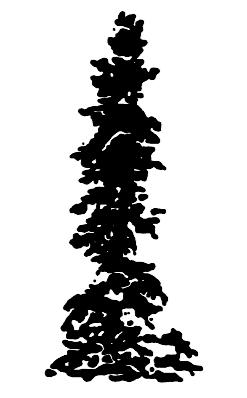

Vespers of the Blessed Earth
For SATB voices (soli or chorus), Percussion (one player), and Organ full score
Commissioned by The Philadelphia Orchestra
World Premiere by The Philadelphia Orchestra Yannick Nézet-Séguin with The Crossing April 2023
With the generous participation of The City of Birmingham Symphony Orchestra
A Brief Descent into Deep Time
UK Premiere by City of Birmingham Symphony Orchestra and Choir June 2024
For SATB voices (soli or chorus), Percussion (one player), and Organ full score T aiga P ress & C hesTer M usiC , L
T aiga P ress & C hesTer M usiC , L Td

Vespers of the Blessed Earth
ISSUU version for perusal only
Earth, nothing more. Earth, nothing less. And let that be enough for you.
—Pedro Salinas
Vespers are evening prayers. My distant model was the Vespers of Monteverdi. But rather than prayers to the blessed virgin, these are vespers to the blessed earth.
A Brief Descent into Deep Time traverses two-billion years of earth’s history, through the names, colors, and ages of the geologic layers of the Grand Canyon.
A Weeping of Doves is grounded on the calls of the beautiful fruit dove (Ptilinopus pulchellus), native to the tropical rainforests of Papua New Guinea.
Sometimes on summer evenings, bright clouds appear low on the northern horizon, pulsing with color as if illuminated from within. As we pollute the atmosphere more and more, Night-Shining Clouds become more widespread, and the earth just grows more beautiful.
The text of Litanies of the Sixth Extinction is entirely in Latin, the scientific binomials of 193 critically threatened and endangered species of plants and animals, ending with Homo sapiens
Aria of the Ghost Bird is my setting of the call of the now-extinct Kauaʻi ʻŌʻō (Moho braccatus), transcribed from a recording of the last male of the species, singing for a mate who would never come.
—John Luther Adams
I. A Brief Descent Into Deep Time 13:30 Chorus (SATB) (playing rubbed stones and small, handheld bells) Timpani
3 Percussion (Crotales, 2 Vibraphones, 2 Marimbas, Tam-Tam, Bass Drum) Piano Strings
II. A Weeping of Doves 5:15 a capella voices (SSSSAAAABBB)
III. Night-Shining Clouds 12:15 Strings
IV. Litanies of the Sixth Extinction 13:15 2 Flutes, 2 Oboes, 2 Clarinets (db. Bass Clarinet), 2 Bassoons
4 Horns, 2 Trumpets in C, Bass Trombone 4 Chimes
4 Choruses (SATB) Strings
V. Aria of the Ghost Bird 4:45 Solo Soprano Piccolo Orchestra Bells Harp Strings
Total Duration: ca. 49:00
Instrumentation
ISSUU version for perusal only
2 Flutes
2 Oboes
2 Clarinets in B≤
2 Bassoons
4 Choruses (SATB) (min. 2 voices per part)
Solo Soprano
Solo Piccolo
Solo Orchestral Bells
4 Horns
2 Trumpets in C
1 Bass Trombone
Percussion 1 (Timpani, Orchestral Bells, Vibraphone, Large Bass Drum, Chimes)
Percussion 2 (Bowed Crotales, Vibraphone, Marimba, Large Tam-Tam, Chimes)
Percussion 3 (Bowed Crotales, Vibraphone, Marimba, Chimes)
Piano Harp
Strings (12-12-12-8-8)
The Strings are seated in four separate choirs, each with the same number of Violins, Violas, ’Cellos and Basses (3-3-3-2-2).
In A Brief Descent into Deep Time (movement I) and in Litanies of the Sixth Extinction (movement IV), there is only one Violin staff in each group, and all the Violins (both 1sts and 2nds) in that group should play that part.
Night-Shining Clouds (movement III) and Aria of the Ghost Bird (movement V) are scored for a full String Orchestra, with staves for both 1st and 2nd Violins. In those movements, all the Strings on stage should play together, even though they are seated in their separate groups.
In Movement III, the dyads in the 1st and 2nd Violins, and the Violas, should be played divisi, and all the single tones should be unison
ISSUU version for perusal only
A Brief Descent into Deep Time
Kaibab Limestone grayish white
ISSUU version for perusal only
two hundred fifty million years
Toroweap Limestone yellow, grey
Coconiño Sandstone pure quartz sand
Hermit Shale deep rust red
Supai sandstone, limestone, shale
Esplanade Wescogame Manakacha Watahomigi red, orange, tan
Redwall Limestone deep red, brown
Temple Butte Limestone purple, grey
Muav Limestone blue grey, slate grey
Bright Angel Shale green, tan, brown
Tapeats Sandstone dark brown
[The Great Unconformity]
Sixty Mile Sandstone sand, cream, tan
Kwagunt Shale red, purple, black
Galeros Sandstone purple, red
Nankoweap Sandstone reddish brown
Cardenas Lavas brown, dark brown
Dox Sandstone orange, red
Shinumo Quartzite purple, white
Hakatai Shale bright orange-red
Bass Limestone blue grey, slate grey
[Pre-Cambrian Unconformity]
Colorado River
Colorado River
Colorado River
five hundred million years
one billion years
Colorado River
Colorado River
Zoroaster Granite pale pink, pale rose, rose, deep rose
Vishnu Schist
two billion years grey, grey, dark grey, dark grey, black
Colorado River
Ecclesiastical Latin
Pronunciation Key
ISSUU version for perusal only
The sung text of Litanies of the Sixth Extinction is entirely in Latin. The pronunciation of vowels and diphthongs should be in Ecclesiastical (as opposed to Classical) style, as follows:
VOWEL PRONUNCIATION
a/ā as in father
e/ē as in met
i/ī as in meet
o/ō as in dog
u/ū as in moon
y as in meet
DIPHTHONG PRONUNCIATION
ae as in met
au as in how
eu eū
oe as in met
ua, ue, ui, uo (after q or ng) kw + vowel
CONSONANT PRONUNCIATION
c before e/ae/i/oe/y as in church
c and ch before all other letters as in character
g before e/ae/i/y as in generous
g before all other vowels as in good
ph as in pattern
th as in toy
Stage Plan
ISSUU version for perusal only
Chorus III (on risers)
Chimes III/ Percussion 2
Chorus I (on risers)
Chimes I/ Percussion 1
Chorus II (on risers)
Chorus IV (on risers)
Chimes II/ Timpani Chimes IV/ Percussion 3
